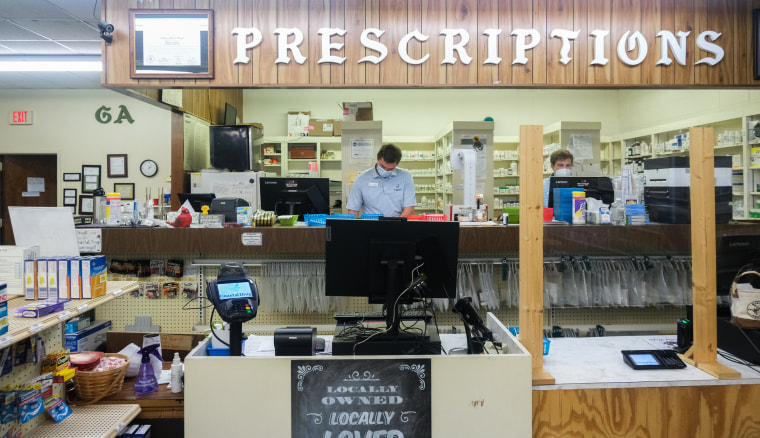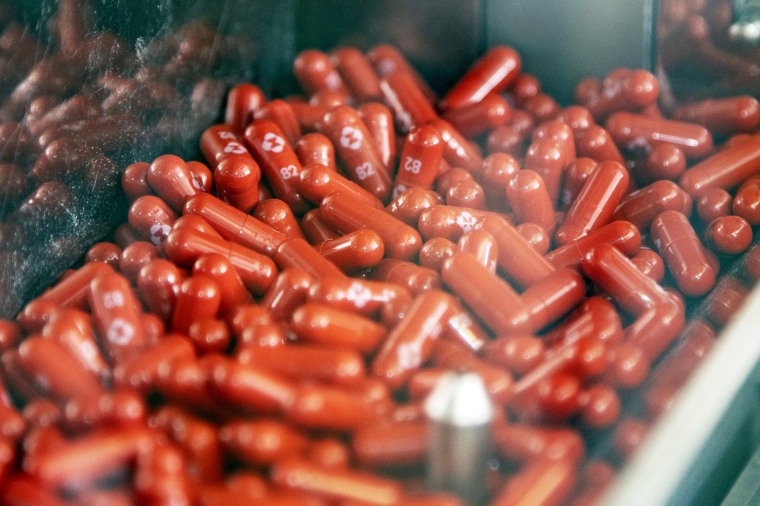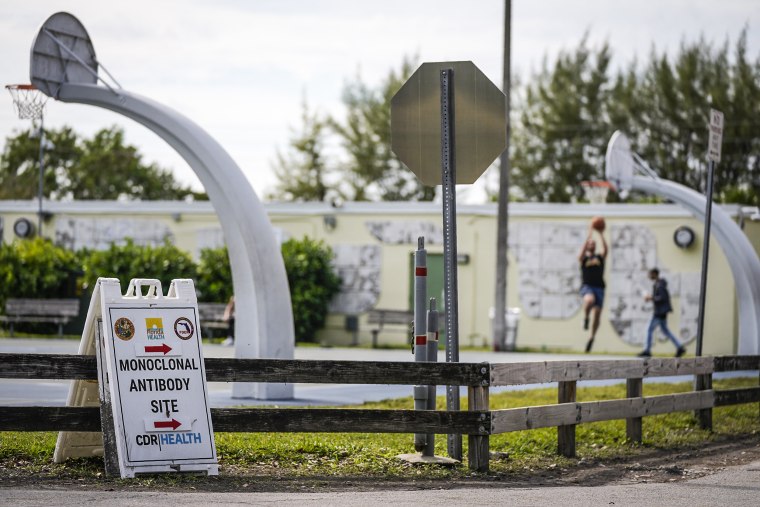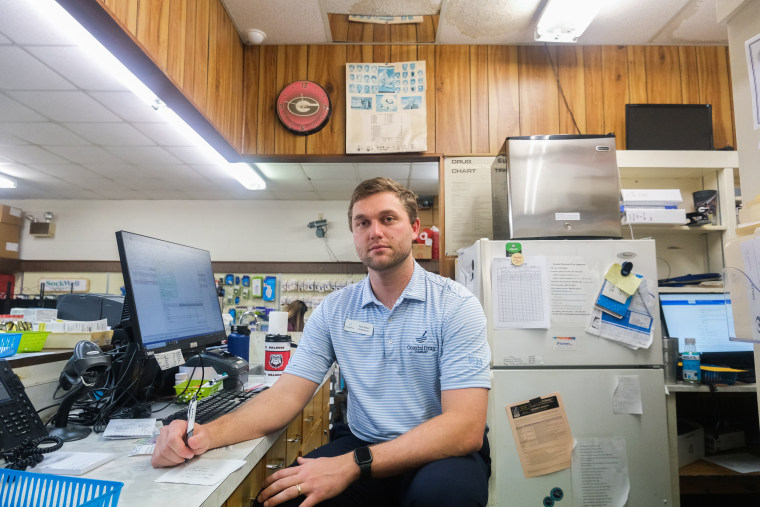When Regina Schearack and her 85-year-old father began to develop Covid symptoms last month, they went to get tested at a pharmacy in Midway, Georgia.
After the tests came back positive, their pharmacist, Pete Nagel, said they had two options if they wanted treatment: Get a doctor to write a prescription and then return to the pharmacy for the newly authorized antiviral drugs or get four monoclonal antibody shots right away — two in the arms and two in the stomach.
Schearack, 59, who had to quit her job to help her ailing father, knew going to the doctor wasn’t an option. She didn’t have one for starters and wouldn’t be able to afford one without insurance. So she and her elderly father, both of whom had been vaccinated, spent an hour in a cold parking lot waiting to have needles poked in their arms and bellies.
“It took a while, and you have to sit waiting outside for it all, so I was worried he’d start freezing,” she said of her father who suffers from memory lapses. “The shots, it’s just so much harder than getting some pills and going home, but we’d have to pay out to see a doctor at an urgent care or emergency room.”
Though the Covid antiviral pills are an easier, cheaper and more effective method of treating the virus, they’re not easy to obtain — especially for those who are low-income or uninsured.
The two pill options, Merck’s molnupiravir and Pfizer’s Paxlovid, each require a prescription from a doctor and the treatment has to start within days of a positive coronavirus test result and the appearance of symptoms. Both are considered to have risks.
Nagel, the pharmacist in Midway, said the drugs may be in high demand, but he’s sitting on his supply because the large number of uninsured patients, largely people of color, in his rural area can't go to the doctor to get a prescription for the drugs.
“I got 500 bottles of molnupiravir just sitting there in my pharmacy. I’ve got the ability to help people, and I can’t give it to them,” he said. “I’ve had four or five different patients die from Covid when I’ve had the pills to help them and couldn’t give it to them.”

A carousel of care
Throughout the pandemic, pharmacists have been allowed to administer vaccines, monoclonal antibodies and coronavirus tests. Now, pharmacists and pharmacy advocacy groups say, they should be allowed to prescribe antiviral pills too.
Pharmacy associations, from those representing small independent retail stores to those lobbying on behalf of national chains, are actively pushing the Biden administration to change the decision made by the Food and Drug Administration that prevents pharmacists from prescribing the antivirals. They argue that allowing pharmacists to prescribe antiviral pills will break down barriers to treatment and get pills into the hands of those who need them, just like when they were given emergency authorization to dispense vaccines, monoclonal antibodies and coronavirus tests.
The National Association of Chain Drug Stores (NACDS), which represents some of the country’s largest pharmacies, has gone so far as to create an illustration that it has shared with members of the administration to display the current carousel of care patients have to make their way through to obtain the antivirals.
The one-page document also shows how allowing pharmacists to prescribe the drugs could keep patients out of unnecessary health care settings, such as overburdened hospitals and urgent care centers. It could also keep Covid positive patients from traveling to multiple locations to try get a prescription and then visiting potentially multiple pharmacies in hopes of filling that prescription.


“There’s currently a gap between what the PREP Act allows pharmacists to do and then what the emergency use authorization [of the antivirals] does not allow them to do, essentially splintering the patient journey,” said Sara Roszak, NACDS’ senior vice president of health and wellness strategy and policy, referring to the 2005 Public Readiness and Emergency Preparedness Act. “We believe that that increases frustration and delays the use of medication that needs to be given to patients really quickly to be effective.”
Chanapa Tantibanchachai, a spokesperson for the FDA, said in an emailed statement that the agency determined that only “traditional” prescribers — such as physicians, advanced practice registered nurses and physician assistants — should be given prescription power over the two antiviral drugs “based on several factors.”
Those factors, she said, included “the drugs’ side effect profiles, the need to assess potential for drug interactions, the need to assess potential kidney function problems (including the severity of potential problems), and the need to evaluate patients for pre-existing conditions that may put them at high risk for progression to severe COVID-19, including hospitalization or death.”
Tantibanchachai did not respond when asked whether the need to evaluate high-risk patients “for progression to severe COVID-19” was made to constrain the antivirals’ use out of supply concerns, or if any efforts had been made to ensure prescribers kept that in mind when writing prescriptions for them.
The drugs are currently in short supply in the United States. In the first month of 2022, the federal government distributed about 600,000 courses of molnupiravir, 160,000 of Paxlovid and 230,000 of Evusheld, an antibody treatment, according to a Department of Health and Human Services website that tracks the therapeutics’ distribution.
Will Gavin, a lobbyist for the law firm of Buchanan, Ingersol & Rooney, who has often worked with the FDA, said that the agency’s concern for the drugs’ supply likely influenced its decision as to who could prescribe it. Keeping prescribing powers in the hands of physicians would raise barriers, he said, but the goal is to ensure that very ill or immunocompromised patients could receive treatment while supplies remain limited.
It’s likely the FDA is aware that this current rollout will leave many outside the traditional health care system without access to the drugs, Gavin said, but the agency is navigating the moment as best it can.
“Unfortunately, the FDA is often faced with these difficult decisions where there’s no perfect solution and there are lots of trade-offs,” he said, noting that the agency’s view could change. “They’re thinking, ‘What’s the best trade-off given the current situation?’ And, at this time, I think they believe, for a lot of therapies, the best option is, ‘OK, let’s have a physician prescribe.’”
‘Same old litany of inequity’
The current barriers, medical experts and ethicists said, only exacerbate a pandemic response in which only those who have time and money can respond to the virus and seek treatment. From the cost and availability of Covid tests to having access to vaccines, they said, the pandemic has increasingly stratified those who can afford the tools to fight the disease and those who cannot.
“Through all this we’ve seen that communities that are in highest need are the ones that have the lowest access, and that certainly includes low-income people and communities of color,” said Dr. Taison Bell, the director of the medical intensive care unit at University of Virginia Health, who has spoken out about pandemic response fairness. “These antivirals are not in huge supply right now and until there is greater accessibility, it’s something that concerns me and anyone else who has an eye toward equity.”
Bell said that for the antivirals to help those in low-income communities who have health needs, the FDA would have to meet people where they are. In some cases, that may be at a pharmacy where they have an established relationship, rather than with a doctor they don’t know, can’t afford or with whom they’re struggling to get an appointment.
Even monoclonal antibodies, which pharmacists are allowed to administer, have been delivered inequitably, according to a CDC Covid-19 Response Team study published last month that examined November 2020 and August 2021.
During that period, Hispanic patients who tested positive for Covid received monoclonal antibody treatments 58 percent less often than non-Hispanic patients. Black patients who tested positive received it 22 percent less often than white patients, and Asian patients received it 48 percent less often.

Arthur Caplan, a medical ethics professor at New York University’s Langone Medical Center, agreed, noting that people in the U.S. may lack insurance, a primary care doctor or even the internet — and they may also live far from a prescriber. He said it was the responsibility of state and national governments to address these issues, rather than assume that people have easy access to the current health care system or know how to use it.
While the Biden administration has sent about 15 percent of the drug supply directly to federally qualified health centers, which provide health care to low-income communities throughout the country, Kaplan said problems within the U.S. health care system are bigger than what these quick fixes can address.
“It’s the same old litany of inequity that we’ve tried to plug like a flat tire through the pandemic by just patching the hole without realizing we have to replace the tire in the roads because the infrastructure is broken,” he said.
Companies like Color — a tech firm that has operated thousands of vaccine and test sites across the country — are attempting to address that infrastructure. Alicia Zhou, Color’s chief science officer, said the pandemic has shown how fragmented the U.S. health care system has become.
While companies like hers have attempted to push some element of innovation and connectivity to the health care system, she said it’s undeniable that the same setbacks have come into play whenever the country rolls out another tool to battle the pandemic.
“Covid has really shown us that there are a lot more capabilities across the system, and they’re redundant capabilities in some ways that have been built because of how siloed it has been,” she said. “I do think there are novel ways to think about delivery of care, but one of the challenges certainly is that there are different regulations on who has the ability to prescribe and has the ability to deliver care.”
But until some of those novel ways become a reality and Americans who have been locked out of the health care system find greater access to it, those concerned with equity for the low-income and uninsured population said each new landmark discovery aimed at defeating Covid is making its way to the country’s most economically vulnerable at a slow trickle.
But Bell continues to hope that will change.
“For all the crap, for all the suffering we’ve gone through, there has to be some lesson that we take out of this — there has to be something that we can hold on to for the future,” he said. “For me, that really is prioritizing health equity and thinking about health care delivery in a very different way than we did before.”

